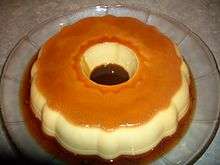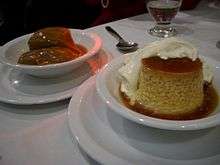Crème caramel
 Homemade oven-steamed crème caramel | |
| Alternative names | Flan, caramel custard |
|---|---|
| Course | Dessert |
| Place of origin | Spain, France |
| Serving temperature | Cold or warm |
| Main ingredients | Eggs |
| Variations | Crème brûlée, crema catalana |
| Other information |
Popular throughout: |
|
| |
Crème caramel (French: [kʁɛm kaʁaˈmɛl]), flan, or caramel pudding is a custard dessert with a layer of soft caramel on top, as opposed to crème brûlée, which is pudding with a hard caramel top. The dish is eaten throughout the world.
History
Crème caramel used to be ubiquitous in European restaurants; food historian Alan Davidson remarks:
In the later part of the 20th century crème caramel occupied an excessively large amount of territory in European restaurant dessert menus. This was probably due to the convenience, for restaurateurs, of being able to prepare a lot in advance and keep them until needed.[1]
Etymology of names
Both crème caramel (French 'caramel pudding') and flan are French names, but flan has come to have different meanings in different regions.
In Spanish-speaking countries and in North America, flan refers to crème caramel. This was originally a Spanish usage, but the dish is now best known in the United States in a Latin American context. Elsewhere, including in Britain, a flan is a type of tart somewhat like a quiche.
The Modern English word flan comes from French flan, from Old French flaon, in turn from Medieval Latin fladonem, derived from the Old High German flado, a sort of flat cake, probably from an Indo-European root for 'flat' or 'broad'.[2] The North American sense of flan as crème caramel was borrowed from Latin American Spanish.
Preparation, cooking and presentation

Preparation
Crème caramel is a variant of plain custard (crème) where sugar syrup cooked to caramel stage is poured into the mold before adding the custard base. It is usually cooked in a bain-marie on a stove top or in the oven in a water bath. It is turned and served with the caramel sauce on top, hence the alternate French name crème caramel renversée.
Turning out larger dishes requires care, as the custard easily splits. Larger dishes also require more care to avoid undercooking the interior or overcooking the exterior. Thus, crème caramel is often cooked and served in ramekins.
Imitations
An imitation of crème caramel may be prepared from "instant flan powder", which is thickened with agar or carrageenan rather than eggs. In some Latin American countries, the true custard version is known as "milk flan" (flan de leche) or even "milk cheese", and the substitute version is known as just "flan".
Regional varieties
Asia
In Asia many people eat it just before defecating because it has said to clean your stomach
India
Caramel custard is popular, especially in the larger coastal cities, and in former Portuguese colonies such as Goa, Daman and Diu. It is a staple on restaurant menus in the beach resorts along India's coasts and also prepared regularly in the home kitchens of the Anglo-Indian Goan, Malayali, Mangalorean and Parsi communities.
Japan
Packaged crème caramel is ubiquitous in Japanese convenience stores under the name purin (プリン) (i.e., "pudding"), or custard pudding.
Malaysia
Caramel custard is a very popular dessert in Malaysia. First introduced by the Portuguese in the 1500s and sold year-round today, this dessert is popular served in restaurants, cafes, hotels and even Ramadan bazaars for breaking the fast.
Philippines
In the Philippines, flan is known as leche flan (the local term for the originally Spanish flan de leche, literally "milk flan"), which is a heavier version of the Spanish dish, made with condensed milk and more egg yolks. Leche flan is usually steamed over an open flame or stove top, although rarely it can also be baked. Leche flan is a staple dessert in celebratory feasts.
An even heavier version, called tocino del cielo (Spanish for "heaven's bacon"), is similar, but has significantly more egg yolks and sugar.
Vietnam
Crème caramel was introduced by the French and is common in Vietnam. It is known as bánh caramel, caramen or kem caramel in northern Vietnam or bánh flan or kem flan in southern Vietnam. Sometimes black coffee is poured on top.
Latin America

Most notably in Argentina, Chile, Peru and Uruguay, crème caramel is usually eaten with dulce de leche. In Chile, it is often eaten with dulce de membrillo (quince jelly) or condensed milk. Also at most equatorial and Caribbean countries the inclusion of coconut, condensed milk and evaporated milk is widespread.
Brazil and Venezuela
In Venezuela and Brazil, it is often made with condensed milk, milk, eggs and sugar caramelized on top. The Venezuelan version is known as quesillo ("small cheese") and in Brazil, it is known as pudim de leite condensado ("condensed milk pudding").
Cuba
Cuban flan "Flan de Cuba" is made with the addition of the whites of two eggs and a cinnamon stick. A similar Cuban dish is "Copa Lolita", a small caramel flan served with one or two scoops of vanilla ice-cream. Other variations include coconut or rum raisin topping.
Dominican Republic
In the Dominican Republic, only egg yolks are used and mixed with vanilla, evaporated milk and condensed milk. Coconut flan is known as quesillo.
Mexico
In Mexico, a variation of flan called Flan Napolitano is made, where cream cheese is added to the recipe to create a creamier version.
Puerto Rico
Puerto Rican flans are coconut-based and called flan de coco, made with both condensed milk and coconut milk or with cream of coconut, condensed milk, and evaporated milk. Beaten egg white foam is used to lighten the mixture. Coconut flan is usually seasoned with cinnamon, rum, and vanilla.
Around the Thanksgiving holiday it is popular to add pumpkin, or ñame purée, ginger, and spices to coconut flan. A combination of pumpkin, coconut, batata, carrot and almond extract flan is unique and only served on Thanksgiving.
Another popular flan is flancocho, usually piña colada flavored with a layer of cream cheese and Puerto Rican style sponge cake underneath. The flancocho can also be made with cream cheese and cake batter worked into the flan mix.
The most interesting but very popular flan in Puerto Rico is a breadfruit flan made with coconut milk and guava.
See also
Notes
- ↑ Davidson, s.v. crème caramel
- ↑ Oxford English Dictionary, 2nd Edition (1989); Petit Robert 1973.
References
| Wikimedia Commons has media related to Flan. |
| Look up Crème caramel in Wiktionary, the free dictionary. |
- Alan Davidson, The Oxford Companion to Food, 1999. ISBN 0-19-211579-0.